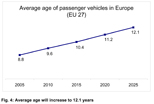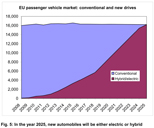First Automechanika Study Looks Down the Aftermarket Road for Next 20 Years
2009/04/07 | By Quincy LiangBesides being the world's largest trade platform for automotive components and repair businesses, the 2008 Automechanika also offered global suppliers and professionals some predictions on the overall automotive aftermarket by publishing the first Automechanika Study.
The 30-page, comprehensive study focuses on the European automotive and repair business and was published shortly before the 2008 fair. The editorial team of TTG (Taiwan Transportation Equipment Guide) translated the Study into Chinese for the daily Show Express distributed to all the Taiwanese exhibitors at this year's show.
In a nutshell
With the research headed by Dr. Ferdinand Dudenhoffer, Director of the Center of Automotive Research at the Gelsenkirchen University of Applied Sciences, the
Automechanika Study aims to offer AM companies with data, predictions and guidance as they try to do business.
The Study foresees drastic changes in the automotive and service markets in EU and non-EU nations over the next 20 years, with quantitative and qualitative changes impending. With decreasing new-car sales and cars increasingly defined by new technologies, these two developments will significantly impact the automotive service business. The full 30-page Study is downloadable from Automechanika's website (http://automechanika.messefrankfurt.com), with the nine key predictions profiled below.
The Automechanika Study, however, was released before Sept. 2008, during the early stages of the financial fallout in the U.S. The global automotive industry since then, including the Big Three, Toyota etc., has perhaps slid further downhill as result of the tightened credit available to businesses and consumers worldwide. So, some of the figures, especially new-car sales in various European Union (EU) nations, seem more optimistic than a reflection of current market trends, but the overall forecasts in the study are quite informative and expected to help global companies map out precise, effective strategies to tap the Europe aftermarket.
Noteworthy is that some of the views in the Automechanika Study are contrary to popular thinking, such as that compromised spending power impacts new-car sales to lead to longer ownership of existing cars to raise spending on repairs and upkeep. Although such predictions are partly correct, but uncertainties as fuel prices or economic factors might decrease mileage driven, which is but one example where AM businesses may not be well-advised to simply rely on instincts and conventional wisdom.
Qualitative & quantitative
With the theme "The Future: Conserving-Fuel Challenges Facing the European Repair Shop and Spare Parts Business," the Automechanika Study explores qualitative and quantitative developments of the AM industry in the EU over the next 20 years.
This Study predicts the trends in new-car sales, total numbers of cars and age structure of cars in the primary markets of Germany, France, Italy, the U.K. and Spain as well as the market blocks of the old EU (EU-15) and new EU member countries (EU-12). Thus the research offers a glimpse into the future of automobiles in Europe by predicting the key components of the car market.
Also the predictions are based on expected changes in fuel prices and CO2 regulations, which will cause noticeable shifts in consumer behavior to have long-term impact on the automotive, repair shop, service station and spare-parts markets in Europe. The Study indicates that these changes will be considerably more radical, long-term than those that took place in the past 50 years in the automotive industry.
1. Passenger vehicles to number 278 million in EU by 2025
Despite increasing fuel prices and green regulations to continue making driving more expensive in the coming years, the number of passenger vehicles in the 27 EU countries will continue to increase: The study predicts some 278 million passenger vehicles in the EU by 2025, an increase of 52 million vehicles or 23% relative to the year 2005; while the vehicular growth in the new EU countries is much faster than in the old EU-15 countries.

2. New-passenger-vehicle sales to drop after 2015
The overall outlook for the repair shop and spare-parts markets is positive, due to the increasing number of vehicles; but not so for new vehicle sales, however, for new-car sales in the EU-15 markets are expected to peak around 2010 and fall thereafter, with the peak in the new EU markets to be later, around 2015. The main reasons for declining new vehicle sales in the old EU-15 markets are the graying population, 25% of all Germans will be 65-or-older around 2025 for example, high vehicle densities or market saturation, and decreasing mileages driven by seniors.

3. The "Cuba Effect"
With declining new-car sales in the EU working against the growing number of cars, the average age of cars will also rise to set up the "Cuba Effect," or one where a growing proportion of the cars in the EU will be older. In Germany for instance, the average car age will increase to 10.2 years by 2025; 13.1 years in France; 11.7 years in the old EU-15 countries; and 14 years in the new EU countries.
4. Increasing business for service market
While the new car market becomes less important and the opposite for the parts and repair business in the EU, the expected increase in turnover for the latter sector will be driven by three factors: first, the total number of vehicles in the EU will increase by 54.6 million between 2005 and 2025; second, rising average vehicle age. In Germany, for instance, 57% of all passenger vehicles will be older than seven years by 2025; while vehicles between six and ten years old require the most repairs; third, repairs in the future will involve considerable use of high-tech electronics, which likely calls for more investment and hence higher fees.


5. Structural changes in service market
Waning new-vehicle business will shift more market shares to the service and used-car segments, setting up more opportunities for carmakers and authorized dealers. Carmakers and reputable or authorized dealers are likely to make new offers for used-cars, affecting key margins in the service business run by authorized dealers. Carmakers will be obliged to adjust service standards and establish new service formats, failing of which will see brand-name dealers lose service market share.
The increasing amount of electronics and driving-assistance (for partially-automated driving) features in vehicles will pose a second challenge for the service segment, with the spare parts and service segments of the future to have to handle increasing demand for retrofitting, repairing and maintaining safety features.
Also the growing number of vehicles and ageing of existing vehicles will generate more opportunities for service providers.
6. Hybrids drive as new challenge
The service market can look to new challenges posed by the turning point in 2010, when increasingly more parallel hybrids, serial hybrids and electric cars will ply EU roads.
Starting in 2010, parallel hybrids as the Toyota Prius will increasingly take market share in the EU from diesel engines; while serial hybrids like the Chevrolet Volt will debut by 2011. The Volt is an example of an exclusive electric-drive, where the main electric motor is backed by a small combustion engine as a generator over longer distances. A combustion engine does not need to run for up to 100 kilometers for a battery can simply be charged via an electric outlet.
Despite improved battery technology, all-electric vehicles will remain a niche product even after 2010 but nonetheless an interesting option for urban mobility.
Such rising transition to hybrid drives and electric motors will pose new challenges for the repair market. Around 2020, all new passenger vehicles will be sold with hybrid drive or a mix of electric and combustion motors, with increasing fuel costs accelerating this change.

7. Lubricant sales slip in importance
Lubricant sales are a key profit driver in the service market; but as cars increasingly operate on electric motors, hence less moving parts and smaller displacements requiring lesser lubrication, repair shops stand to lose considerable business in selling lubricants, which will be offset by new business in maintaining and replacing high-performance batteries.
Major changes can also be expected in the maintenance market during the transition to more hybrid drives, with one result being smaller combustion engines using lesser motor oil. So a replacement must be found for lubricants as a traditional sales and profit driver.
8. Growing market for LPG retro-fitting
Increasing fuel prices and tax regulations will find new markets for LPG or liquefied petroleum gas in certain countries. Germany is an outstanding example: its tax exemption for driving on natural and LPG available through 2018 and the generally high gasoline prices, the market for LPG retro-fitting has been booming. More than 170,000 of the 232,000 cars on German roads today are retro-fitted for LPG.
The market for retro-fitting to LPG is a key potential source of turnover which however will gradually decrease after 2015.
9. "Value Repair" to be important
Changes in the consumer preferences in vehicle sales in the EU are expected to rise in the coming ten years, with such shifts to demand changes in service formats and offerings. The potential for sales of premium car brands will increase on the one hand, while significant growths in budget cars are also anticipated.
The price-sensitivity of budget-car buyers will call for repair shops to offer new formats to suit such tendencies. "Value Repair" will remain a recurring theme in the next 20 years-not only for older used-cars but in the new segment of low-cost vehicles as well.

